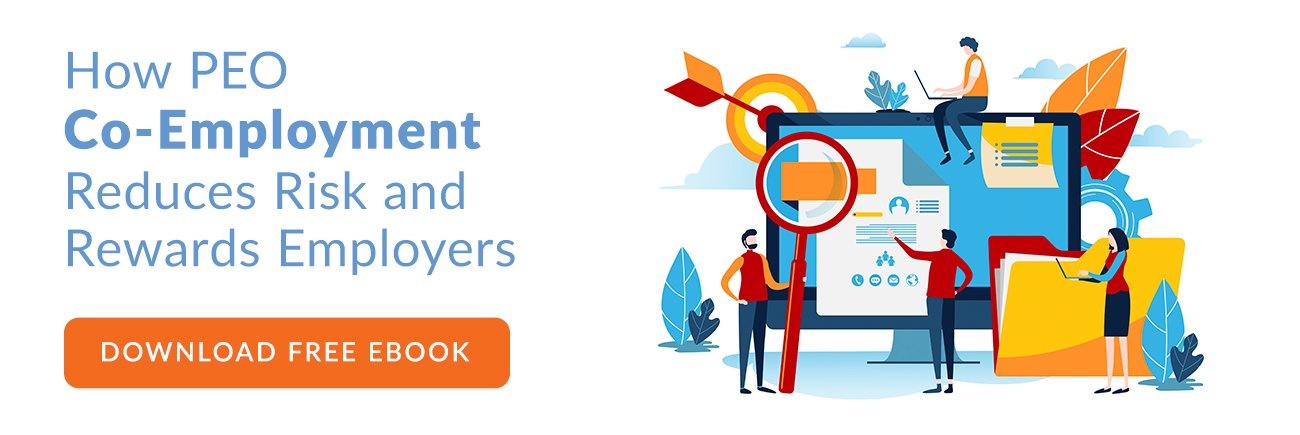As workforce management and HR compliance become increasingly complex, companies are searching for ways to simplify them. One of these methods is co-employment.
Co-employment is a collaboration in which two or several companies share the administrative responsibilities that employers usually bear on their own. These companies enter a contract, according to which the client company works with a co-employer to manage certain HR functions.
Even though the co-employer takes over many complex HR-related tasks, the client company doesn't lose control over its employees. Just the opposite, business owners gain an opportunity to manage employees' day-to-day operations and supervise their performance without wasting time on administrative burdens like payroll and benefits administration.
Companies often confuse co-employment with joint employment and employee leasing. To prevent this from happening to you, keep reading to learn what co-employment really is and how client companies benefit from it.
What is co-employment?
Co-employment is a relationship between an employer and an HR service provider that involves sharing liability and responsibility for employees.
An HR outsourcing provider companies have a co-employment partnership with is formally known as a Professional Employer Organization (PEO). A PEO is a full-service human resource outsourcing service that handles many administrative HR tasks for the client company.
When two companies sign a co-employment contract, the employer continues making all decisions related to day-to-day employment and employee managing decisions. Meanwhile, the PEO takes care of administrative HR tasks, including:
- Payroll processing
- Filing Employment Taxes
- Providing and Administering employee benefits
- Workers' compensation insurance
- Workers' comp claim management
When handling payroll taxes, PEO can file them under their federal employer identification number (FEIN) rather than the FEIN of the client company. For the IRS, this turns the co-employer into an "employer of record." As the employer of record, the PEO takes on federal tax liability and penalties. This dramatically reduces the client company's risk in case of non-compliance.

Co-Employment vs. Joint Employment
Joint employment is a type of collaboration when two companies share control over the terms and conditions of the employee's work arrangement. Some examples of shared responsibilities are:
- Paying salary
- Making decisions about employee's future with the company
- Arranging training
Joint employers have equal rights to hire and fire employees, share control over the employee's rate and schedule, and manage employment records. They are also both responsible for complying with employment laws.
An example of joint employment is when a staffing agency provides employees to another company.
On the other hand, with co-employment, all key decisions are made by the client company. The co-employer only takes over administrative tasks and may share liability for payroll taxes.
Co-Employment vs. Shared Employment
Shared employment occurs when employees split their time and duties between two or more employees. For example, a veterinarian splits their time between two vet practices. They can remain on one company's payroll while doing work for another.
In this case, the principal employer is fully responsible for managing the worker's schedule, payroll, benefits, and other HR-related issues.
The client company of a co-employer can have employees engage in “shared employment.” The two concepts are not mutually exclusive.
Co-Employment vs. Dual Employment
Dual employment involves one employee working for two or more different employers. Unlike the situation with shared employment, these two employers are completely independent.
The employee works a percentage of the full time for each employer. For example, a veterinarian can work 30% of their time for one practice, 50% - for another practice, and 20% - for a third practice. Such arrangements comply with the Fair Labor Standards Act (FLSA).
In dual employment, each employer hires the worker separately and becomes responsible for HR compliance, wages, benefits, and workers' compensation. Both employers can have a co-employment agreement with different HR service providers.

Co-Employment vs. Employer Coordination
Employer coordination is an arrangement that involves two companies coordinating their employment practices to achieve shared goals, such as cutting costs or improving productivity.
In such an arrangement, each employer is fully responsible for HR tasks related to their employees. These companies don't share any liability for the other party's workers or help with another company's HR responsibilities.
Benefits of Co-Employment
The key benefits of entering a co-employment agreement with a PEO include:
- Access to better quality benefits for a reasonable price
- Gaining more time to focus on daily employee assistance and hiring decisions
- Delegating administrative tasks including payroll, payroll taxes, benefits administration, and workers' comp claims to the experts.
- Sharing liability for filing payroll taxes
- Gaining access to high-quality HR software
- Leveraging robust compliance support
When you use a PEO in a co-employment arrangement, you don't relinquish any control as you would in a joint employment partnership. Instead, you share liability and gain valuable time to focus on essential HR matters while the PEO handles complex and time-consuming tasks.
How do you avoid co-employment risks?
Some staffing agencies take advantage of co-employment to engage independent contractors without handling such responsibilities as payroll and payroll taxes. Alternatively, a staffing agency can treat the independent contractor as an employee, putting the agency and client company at risk of an employment lawsuit.
When you work with a PEO, you keep co-employment risks at a minimum. In this collaboration, co-employment is a mechanism that benefits both parties while maintaining compliance with HR laws.



